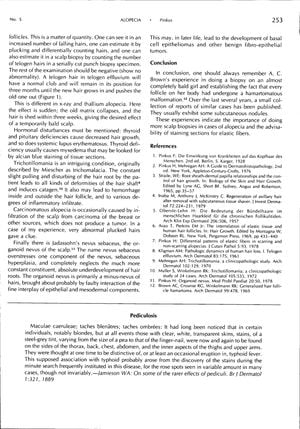Pediculosis
June 1980
in “
International Journal of Dermatology
”
alopecia scalp biopsy telogen effluvium telogen hairs X-ray alopecia thallium alopecia matrix collapse hormonal disturbances thyroid deficiency pituitary deficiency systemic lupus erythematosus trichotillomania trichomalacia catagen induction carcinomatous alopecia Jadassohn's nevus sebaceus organoid nevus hair shaft deformities hamartomatous malformation elastic fiber staining hair loss scalp biopsy hair shedding hair roots hair pulling hair deformities hair follicle malformation

TLDR Scalp biopsies are important for diagnosing hair loss conditions.
The document discusses various causes and characteristics of alopecia, emphasizing the importance of scalp biopsies in diagnosing hair loss conditions. Telogen effluvium is characterized by an increased number of falling hairs and can be estimated by counting the number of telogen hairs in a scalp biopsy. X-ray and thallium alopecia result in sudden hair loss within three weeks due to matrix collapse. Hormonal disturbances like thyroid and pituitary deficiencies, as well as systemic lupus erythematosus, can decrease hair growth. Trichotillomania, described as trichomalacia, involves the patient pulling their hair, leading to hair shaft deformities and catagen induction. Carcinomatous alopecia may occur without forming a tumor, due to infiltration from carcinoma. Jadassohn's nevus sebaceus is an organoid nevus with underdeveloped hair roots, which may lead to tumors later in life. The document concludes with a case of a girl with hamartomatous malformation of every hair follicle, highlighting the need for more scalp biopsies and elastic fiber staining in alopecia cases.





